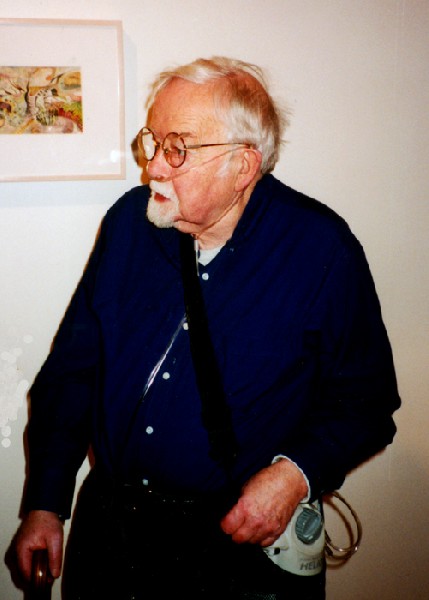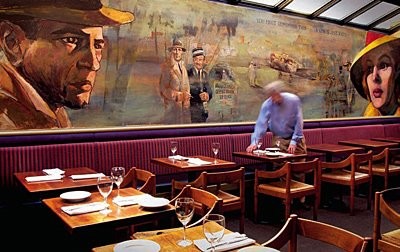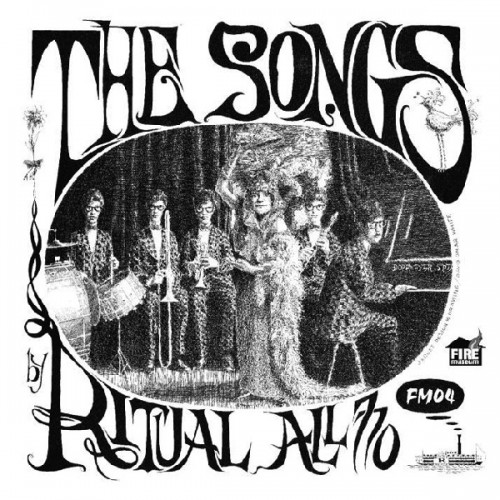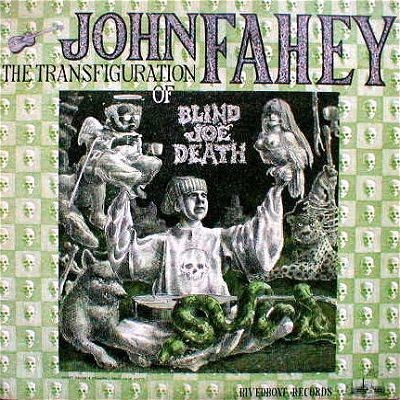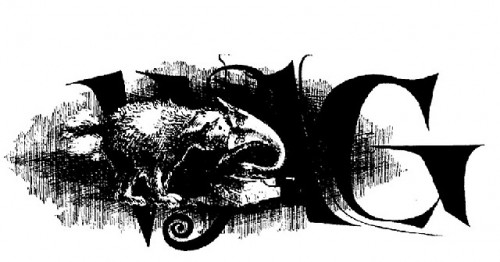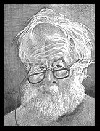David Omar White - A Remem-bromance
Recalling Artist/ Illustrator and White Rabbit
By: David Wilson - Nov 14, 2009
David Omar White was wont to say to me, more often than I appreciated, "There are only two kinds of people in the worldÂ… young punks and kindly old gentlemen." He left me with no doubt which category he reserved for himself or which of us was the younger. Such expressions were common whenever there was a philosophical or political point of disagreement between us or more often on those mornings when he had yet to have a bit of the hair of the dog and I was more focussed than he was willing to tolerate.
I first met Omar in the early 60's and can remember going to his house in Watertown to buy a couple of brightly colored fanciful animal prints as gifts for my young nephews and meeting him and his wife, Ann, for the first time. Our meeting was fleet and at that time I had no idea how entwined we would become over the next decade.
Shortly after that first encounter, I started to publish Broadside of Boston, folk-music and coffeehouse news. In the course of doing so I often found myself making the rounds of the coffeehouses on Charles Street in Boston, one of Omar's principal hang-outs. Though he spent more time in the hallowed Sevens bistro, its walls hosting a multitude of his sketches, I was reminded of him every time I visited the Turk's Head for the water heater which took up a corner of that small venue was adorned with an Omar original, his vision of the head of a Turk.. Needless to say, David was a budding legend in that neighborhood, which included the Nexus Gallery where he was a featured artist.
One night in the mid 60's we met at the Turk's Head and over coffee we got to talking about a possible collaboration. We batted ideas around, but never came up with anything that made sense. In '65 Ralph Dopmeyer commissioned him to do a record cover for his first lp on the Riverboat Label. It was the iconic John Fahey album "The Death and Transfiguration of Blind Joe Death." I suspect that it is this piece of art which has been more widely viewed than any other he has done. I say that because it stacked up substantial sales not only here, but in the UK and across Europe. Stanley Kubrick was a fan of the album and the cover appeared along with that of the 2001 film score jacket in a record store window during a scene in "A Clockwork Orange."
David also did three more covers for Riverboat, a reputed sea chantey album no copy of which I ever saw, the Alan Sondheim avant-garde Jazz album, Ritual All 770, and the off the wall, quirky and charming almost indescribable Swedith In Tina.
It is a shame that David sold these pieces outright foregoing a smaller up-front fee with a royalty. He would have been far more financially secure, but he had given so much of his art away that when he could get something for it he wanted as much as he could get at the moment not trusting what the future might bring.
When the Nexus Gallery was sold to Tom Wilson and switched from a high-end gallery to a hip art boutique, David was as I remember at loose ends. I am not sure how it exactly came to be but at some point in late 66 he ended up installed in a storefront, one of two that Broadside was renting on Columbia Street off Central Square in Cambridge. Essentially he traded filler art and story illustrations for studio rent and the arrangement was satisfying to both of us.
It is from this period that the following fond memories of David spring.
In early '67 when Broadside celebrated its fifth anniversary David treated us all to caricatures whipped up on the spot. Remembering this, Sandi Mandeville, Broadside's managing editor writes in a recent email:
"Broadside hosted a party for staff and friends. Omar decided to create caricatures of the staff. In that pre-modern time, we "set type" for the magazine by typing all material, and I was one of the "typesetters," being relatively quick on the keys. The drawing he created of me showed huge hands flying over the keyboard. My cousin, Susan, who was visiting from New York, also attended the party. Omar graciously included her in the set of drawings. The drawing he made was not a close resemblance (as most caricatures are not), but was a perfect image of her mother, who had passed away several years before, and whom Omar had never met. Susan still cherishes that piece of art."
And it was not uncommon for David to find immediate connections with chance acquaintances. He made such connections easy for those he met. Confirmation of this occurs over and over in the other notices of his passing that have appeared in the press, links to which may be found scattered throughout this story or posted at the end.
Shortly after his ensconcement on Columbia St., we collaborated on Omar Quarterly a portfolio of some of his existent drawings with the idea we might publish subsequent issues. The art was printed on only one side of the page to make the images easy to separate and frame. David created a cover, an illustration of himself on a towering stool at an artist's desk sketching while wolves prowled below trying to nip his sandaled toes. and backpiece. Along with Sandi Mandeville's assistance we found a limited quantity of a textured stock we thought elegant at a good price and used it all to print up a couple hundred issues. While it did not sell like hotcakes, we did exhaust the print-run in about 3 months, much of it through the auspices of the Nexus, though with the number of copies David gave away we just about broke even.
1967 to 1970 were years of social chaos. The first few issues of Avatar were published out of the Broadside office and David was always ready with a contribution including, an experimentation with a comic strip with which he had been toying called the Snacklestalkers. Confrontations with authority became daily occurrences and we were harassed regularly with citations for zoning violations, safety inspections and the occasional rock through our plate glass windows. David took it all with aplomb. He once pursued and chastised an FBI agent who had arrived to take one of our office staff away, because the agent was leaving the office unattended and open without knowing whether he, David, had any right to be there alone.
During the summer of '68 recurring street demonstrations and their attendant riot police inspired David to experiment with a new medium and he began to construct a seven foot plaster sculpture of a policeman in full gear. Since it was August and A/C was unknown to our offices, he often worked with the front door wide open and the statue in full view. It was not uncommon for local residents to gather around the door and comment on his creation. Sandi remembers:
"Â… at a time when porcine epithets were used synonymously with "cop," Omar decided to create a larger-than-life statue of a real police officer. Late one warm August evening I was with Omar in his store-front studio in Cambridge. The door was open and Omar was working on the statue, when I noticed out of the corner of my eye a flashing blue light outside. I turned to the open door to see two police officers silently watching Omar work; he was unaware of their presence. Finally, one officer turned to the other and said, "Looks just like you"! Omar then engaged the officers about his work. The conversation was genial. One of the officers went back to their vehicle and returned with a police baton, which he contributed to the artistic cause. The baton ended up in the hand of the statue. As this misuse of public property took place over 35 years ago, I doubt the officers will be reprimanded."
Now, David was more or less living in his studio space, his marriage pretty much in shambles at this point. Since his studio space lacked much in the way of comfort or facilities he spent a considerable amount of time next door in our office where he had access to a few creature comforts. It was during this time that he and I shared much of our life-stories with each other.
He had me rolling on the floor as he related his adventures upon leaving North Dakota for the west coast while still a stripling. He told me that he had been dropped off on the road at the end of one hitch and having hiked several miles with darkness fallen he left the road, climbed through a fence and stumbled through a field until he found a space suitable to spend the night. He opened his blanket, wrapped himself in it and drifted off to sleep. Awhile later he awoke to the drone of what he first thought to be a motor that came closer and closer until he thought it was almost on top of him and large clouds of dust rose up all around him. He wanted to move away, but unable to see through the dust, disoriented by the noise, he sat as still as he possibly could watching flashes of light in the near distance accompanied by loud rumblings. In his still half asleep state he imagined that he was in the middle of a freak storm which consisted of wind and lightning although no rain. The ruckus lasted he thought, for about a half hour and then stopped as suddenly as it had started. Relieved, he lay down and went back to sleep. Back out on the road the next morning and trudging westward he came upon a sign proclaiming "Warning. US Army Night Bombing and Strafing Range. Do not trespass."
We were always trying to come up with ideas that would earn David some money. LP artwork had become an art-form in itself and with the four covers he had done we encouraged him to solicit commissions from the major labels. He sent out a number of samples with cover letters, but got no acceptances. One hilarious response from a major label said they liked his work, but did not use engravings. David's technique was so detailed they could not imagine it could be produced in any way other than an engravingÂ…
Handwritten signs proliferated around the office As I left the office one afternoon I noticed a small penned sign at eye heightÂ… "Don't forget to turn off the hotplate, Dummy," a reminder he wrote to himself. Another sign hanging on the back of the office door ready for posting in the window simply said "Indisposed" I found it quite puzzling until I noted another sign on the bathroom door, "Sposed." David never conceived a pun to which he wouldn't lay claim, good or bad,
During this time Broadside had switched format from magazine to tabloid. A number of the cartoon panels and strips we had been running had ended and I was looking for a new one. Grace Slick's White Rabbit had become a counterculture anthem and I created and wrote a strip which we titled "The Adventures of the White Rabbit in the Great Society" I wrote the script for the panels and a staff member, Melinda Cowles, drew the white rabbit in various poses. After a few issues she came to me and asked to be relieved because friends who read the strip and saw her name on it were asking her to explain its often cryptic observations. She told me she could not explain what she did not understand and wanted out. Reluctantly I caved, and after giving it some thought asked David if he would be willing to do a dozen or so poses of the white rabbit that I could mix and match to the panel text. He agreed and a day later I had more than a dozen images with which I could play. After a few such strips, David suggested that I give him the text and he would draw more appropriate poses. One issue he asked if he could use an idea he had and I by then knowing I was drying up for ideas willingly passed the burden on to him thinking I was getting him to take a load off my back. Little did I know that he would develop WR into the institution it became.
One afternoon, slouched in a chair across the desk from me, with his typical hunch and squint look, an Omar trademark, he told me he was trying to find a way to acquire a motorcycle as a means of getting around town. I suggested that he talk to Howard Ferguson, owner of the King's Rook Coffeehouses in Marblehead and Ipswich and also a Honda dealer. I suggested he could probably work out a swap for some artwork for at least some of the cost. David ended up doing a watercolor portrait of Howard and his family and providing him with a set of his Seven Deadly Sins prints. They currently hang on the walls of a 125 year old farmhouse in Nova Scotia which I have visited every summer for the last 30 + years.
During the Boston trial of Benjamin Spock, an SDS splinter group took up office space across the street from us and started to publish a daily newspaper covering the trial proceedings under the banner of the Boston Free Press. David was quickly involved with them, contributing illustrations for their stories and developing friendships which were to last for years.
Within a year or so the number of alternative press publications had multiplied and with the end of the Spock trial the proprietors of the Free Press encouraged Broadside to take it over and meld with it. David enthusiastically campaigned for the merge and we agreed. But the times they were a changing! For reasons too complicated to parade in this paean to David, Broadside (and the Free Press) was in decline. David gravitated to The Phoenix and the Real Paper asking my permission readily given to continue the White Rabbit in their pages. Later he took it on to the Boston Sunday Globe and for awhile there was a possibility of national syndication. I often told him when ending conversations that if it ever got syndicated and he got rich I was going to sueÂ… I doubt he thought me serious.
In any event, David moved on hanging out in other offices, dropping by every once in awhile. He picked up freelance work from the Globe and did court drawings for one of the local stations. For awhile I think he had a space at an artist's collaborative over on Huntington Ave, but before long he was settled into another cooperative which had been established in a former School in North Cambridge. We saw each other rarely after that, but when we did it was as if we had parted the night before. I heard he remarried to a young woman with whom he had a son, then once when we met he had spent the summer on board a boat studying whales off the coast of Labrador and Newfoundland. At one point I contributed a computer to his endeavors, but as did many in the 80's he devoted only cursory investment of energy to it and found it more confounding than useful. One meeting while he was living in Somerville resulted in my arranging a month long showing of his work at the Cambridge Center for Adult Education on Brattle Street in Harvard Square and on very rare occasions our paths would cross at the Casablanca.
A few years ago he called me to arrange some tutoring on a new computer he had acquired. I had become as nomadic in my latter years as he in his former, and when I returned to the area and tried to contact him neither the email address nor phone numbers I had were current. I kept meaning to track him down, but never got around to it. Then, suddenly, it was too late.
I regret that I missed sharing much of his latter years. I was pleased to read Charlie Giuliano's glowing review of a gallery show at "Bigredandshiny.org" and to know right up to the end he was doing what he lived to do.
Sandi Mandeville (Tatman) returning for a visit this summer was dismayed to hear of his passing and remembered: "In the last years I spent in Boston, I experienced a few personal setbacks. Omar was always an available confidante. In 1970 I married and moved from Boston to California. Before leaving, I brought my husband-to-be to meet the Broadside staff. When I introduced him to Omar, Omar said to him: "Be gentle; she bruises easy." I never saw Omar again, but will always remember his gentle manner and concern."
I can still hear his voice, that laconic drawl, the pregnant pauses in his pronouncements that signified he was getting ready to zing me, the quiet half swallowed chuckles. I see him on my mind's canvas as he was, his unique body language, the way he shrugged more by dropping his head than raising his shoulders, the wry twinkle in the eyes that presaged an internally rehearsed observation he knew would be controversial, the pursing of his lips that signaled an objection he was about to raise. His stamp on my life will always be with me.
So, farewell David, you were far from perfect, by your own admission not so hot as either a husband or a parent, but you were a damned fine friend, one hell of an artist, and without a doubt, a kindly old gentleman.
Boston Globe obituary
Wicked Local Somerville Obituary
Casablanca website
Omar's Legacy
Images from The Chess Pieces
Link to The Songs
Link to Swedith in Tina
Link to Genovese Sullivan Gallery


